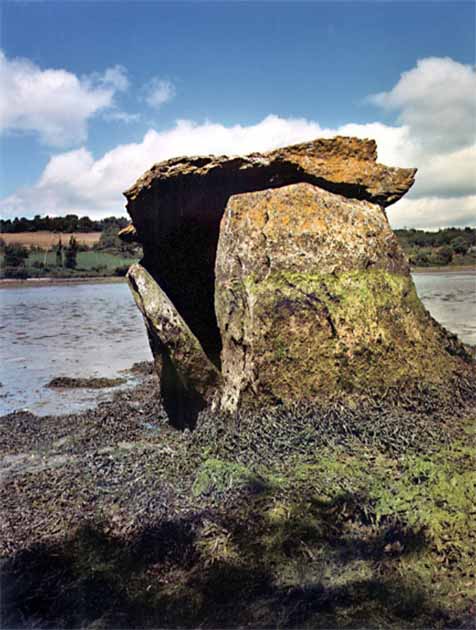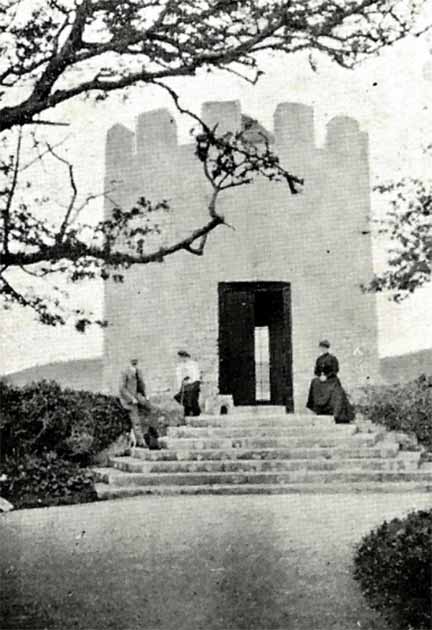
Cork Harbor Rock Structure Declared A Stone Age Tomb
Ever since the discovery of a stone dolmen on the eastern shore of Cork Harbor in southern Ireland many years ago, archaeological opinion has been divided over the exact nature of the Carraig á Mhaistin stone. New research now seems to prove that it is a Stone Age tomb, as many experts have always believed.
According to the Irish Examiner, Connemara-based archaeologist Michael Gibbons claims that his research has uncovered conclusive evidence regarding the age and purpose of the monument. He maintains that it is now possible to confidently identify the Carraig á Mhaistin stone at Rostellan, also known as the Rostellan dolmen, as a megalithic tomb. It had been sometimes suggested that it was an 18th-century folly, a purely ornamental garden building serving no useful purpose.
- 6,000-year-old cremated remains discovered in megalithic tomb in Ireland
- Carrowmore Megalithic Cemetery: Where Prehistoric Ireland went for Ritual Burials in a Big Way

A close up of the Rostellan dolmen, Carraig á Mhaistin, which has been recently identified as a Neolithic inter-tidal tomb. (Howard Goldbaum / CC BY NC 4.0)
Carraig á Mhaistin Origin: A Long-Standing Debate
Historian and author Kieran McCarthy has touched upon the debate regarding the provenance of the Rostellan dolmen in his book The Little Book of Cork Harbour. An excerpt from the book published in the Cork Independent in 2019 explained that the dolmen standing in Rostellan, at the eastern end of Cork Harbor, is similar to portal tombs, but it is difficult to categorically identify it as such.
A portal tomb is a single-chamber megalithic tomb. It marks a burial site in a very distinctive way, with two or more upright megaliths supporting a large flat horizontal capstone or ‘table’ at an angle.
The Cork Harbor monument is comprised of three upright stones topped by a capstone, which had once fallen but was later re-erected. At high tide, the site gets submerged, and it is difficult to reach it across the mudflats. An easier route is through the adjacent Rostellan wood. The wood was planted as part of the former estate of Rostellan House, built in 1721 by William O’Brien (1694-1777) the fourth Earl of Inchiquin.
The Carraig á Mhaistin stone has been sometimes identified as a folly because the estate has a folly in the shape of a castle tower nearby, named Siddons Tower after the Welsh-born actress Sarah Siddons. According to the Heritage Daily, the folly was built by Murrough O’Brien, the first Marquess of Thomond, in the late 18th-century. This led to the suggestion that the Carraig á Mhaistin stone was another of the Marquess’s follies.

The Siddons Tower folly, now in ruins, is located near the Carraig á Mhaistin dolmen, contributing to the cairn’s misidentification. (Public Domain)
This uncertainty over the monument’s age has meant that it missed out on its due place in the survey of megalithic tombs of Ireland conducted by Professor Ruaidhrí de Valera and Seán Ó Nualláin over 40 years ago. According to the Irish Examiner, Gibbons stated, “At that time, it was suggested that it could have [been] a folly or type of ornamental structure commissioned by local gentry at the nearby Rostellan Castle estate, and dating from the 19th century.”
- Mysterious Megalithic Monument Found at Carrowmore is Unlike Anything Seen in Ireland
- The Haga Dolmen: Neolithic Burial Chamber Sits Amidst an Impressive Megalithic Landscape
New Evidence for the Megalithic Tomb Theory
Gibbons said that his recent field trip to the site has led to the discovery that the small chamber at the tomb stands at the western end of a cairn, which is 25 meters (82 feet) long and 4.5 meters (14.7 feet) wide. This is pretty conclusive, as portal and court tombs “occasionally have intact long cairns which are both intended to provide structural support to the chamber itself, and to enhance visual presence in the landscape,” the Irish Examiner quotes him as saying.
He added that the cairn is partially submerged in “estuarine mud”, and a substantial portion will likely be uncovered below the surface. Although it is not known when rising sea levels submerged the area, for the last 2,000 years the sea levels in this part of the harbor are believed to have been stable.
Despite its disputed provenance, some guidebooks have listed the Carraig á Mhaistin dolmen as Ireland’s only inter-tidal portal tomb. While Gibbons agrees with them that the dolmen is indeed an inter-tidal megalithic tomb, he maintains there are in fact two such tombs in Ireland. The only other known inter-tidal portal tomb is at “the Lag” on the river Ilen, between Skibbereen and Baltimore in West Cork.
Interestingly, portal tombs are often known locally as “Diarmuid and Gráinne’s bed”, in reference to the Irish folktale, “The Pursuit of Diarmuid and Gráinne”. The tale tells of a love triangle between the great warrior Fionn mac Cumhaill, the beautiful princess Gráinne, and her paramour Diarmuid Ua Duibhne.
Gibbons’s research should give the Rostellan dolmen its rightful place among the megalithic tombs of Ireland. As a Neolithic tomb, it holds far greater archaeological value than as an 18th-century folly - an architectural extravagance of no particular use.
Top image: New research helped identify Carraig á Mhaistin, the Rostellan dolmen, more definitively as a Stone Age megalithic tomb. Source: Howard Goldbaum / CC BY NC 4.0
By Sahir Pandey
References
McCarthy, K. May 22, 2019. Prehistoric Cork Harbour. Cork Independent. Available at: https://www.corkindependent.com/2019/05/22/prehistoric-cork-harbour/.
Partially submerged structure is a prehistoric tomb. October 18, 2022. Heritage Daily. Available at: https://www.heritagedaily.com/2022/10/partially-submerged-structure-is-a-prehistoric-tomb/145014.
Siggins, L. October 18, 2022. Research finds mysterious structure in Cork Harbour is prehistoric tomb. Irish Examiner. Available at: https://www.irishexaminer.com/news/munster/arid-40986065.html.
















Comments
The prevailing theories, particularly that the ancient aboriginal people had so-called ‘elites’ and they constructed ornate subterranean burial chambers, filled with valuable things, (a lot of work there!) to put their dead, rotting bodies in, instead of the well-known traditional method of funeral pyre, IS PLAIN SILLY. Totally illogical that people, living primitive lives in comparison to today, would do that back then. A house of cards can’t stand forever.
Nobody gets paid to tell the truth.
If you make an assertion, you have an obligation to back it up.
Pete, you have nothing but preconceived ideas and a closed mind. You’re not even willing to entertain theories outside of your narrow worldview. And yes, your comments are incomprehensible. Your knowledge base is shallow. Please read an actual book.
Here’s some free truth – having thoughts and being intelligent are not the same.
Go here – https://www.ancient-origins.net/user/154012/track – look down the list, select a topic you might be interested in, and read my thoughts on it. I’ve made hundreds of comments here, and you’re the first who has indicated trouble understanding them. But in a nutshell, if you want to categorize me, simply consider me a SKEPTIC, and one who has no time for petty trolls.
Nobody gets paid to tell the truth.
What you wrote in your first comment isn't clear or coherently expressed to me at least. Perhaps other readers can shed some light to help me out. I have no idea what you are trying to say or point out. Maybe English isn't your first communication language and you have difficulty expressing your thoughts succinctly. But Again.... If you would please commit a little time to explain what you are talking about, I'd be very appreciative of learning another point of view on this topic... Or any topic. And of course presenting actual facts and not just opinions are essential for us to take your contributions seriously. I am learning that a lot of "history" many of us have been taught is just plain wrong. And I have read that many researchers' lives are made extremely difficult when they propose data corroborating ideas that go against the ingrained accepted paradigm. So if your information is "more correct" pertaining to this article, I'd really appreciate learning what you have to contribute. If you can't honestly look at your comment and see where you can explain yourself a bit better, then I can't help you. For every topic I do my best to do what some famous man once said, "to view the world through child like eyes". This approach removesb as much confirmation biases as much as humanly possible. This means if you already believe you completely know all about a subject you will dismiss others ideas and findings which in many instances supersede the handed down way of thinking.
And by the way, your stupid tag line, that nobody gets paid to tell the truth, is just plain wrong. Yes a last portion of this world is corrupt. However, I know plenty of people that get paid to tell the truth and I'm one of them. There were numerous times in my career that people offered me even more money to not tell the truth, but if I had done that, I probably would have turned out to be a grumpy old turd that would say things like "Nobody gets paid to tell the truth". If you really believe your tag line, then you may want to contemplate your own life choices and the people you choose to associate with.
What’s not clear?
Nobody gets paid to tell the truth.
Pages